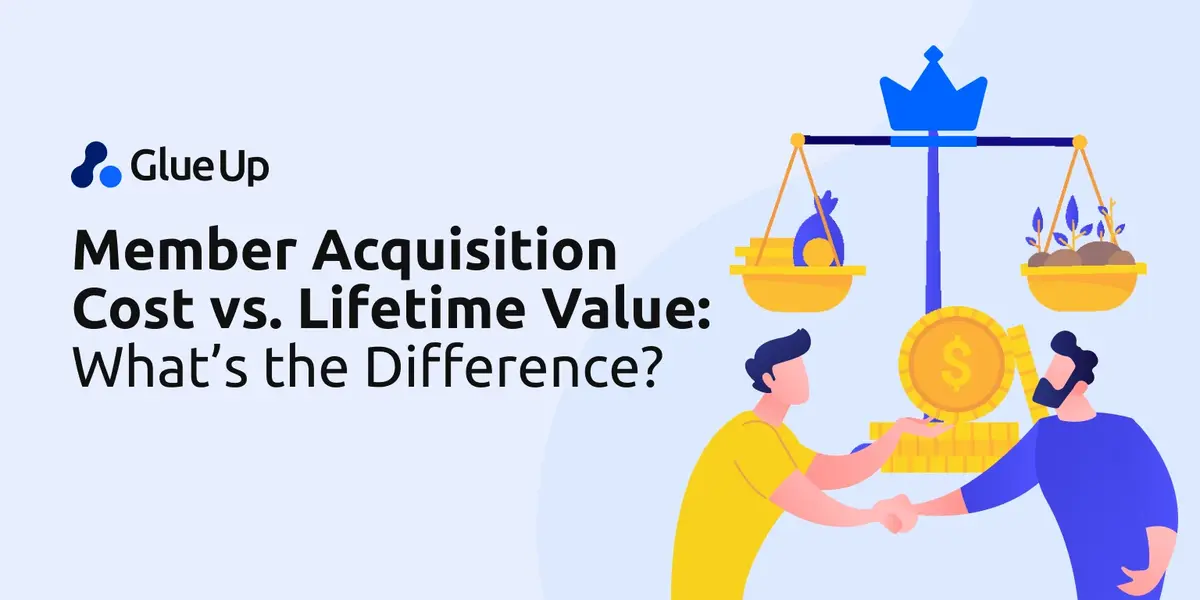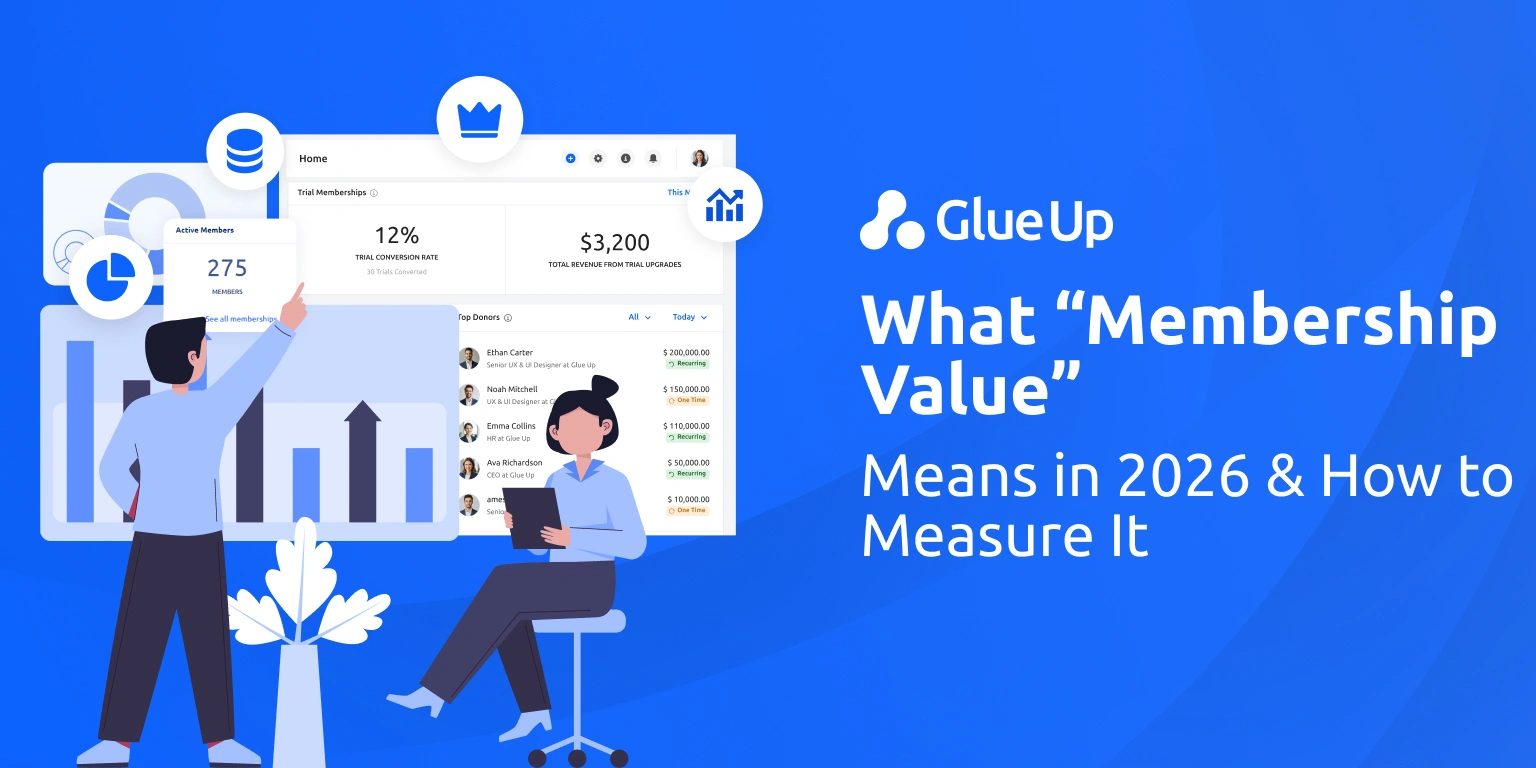
To ensure your organization makes smart decisions about member recruitment and engagement, it's critical to understand two key metrics: member acquisition cost and member lifetime value.
While the two concepts are related, they provide different insights that together paint a full picture of your membership economics.
Let's discover what each metric means, how to calculate them, and why tracking them is so important.
Key Takeaways
- Member Acquisition Cost (MAC) measures the average cost to gain a new member, calculated by dividing total recruitment expenses by the number of new members acquired in a given period.
- Member Lifetime Value (MLV) represents the total value a member brings to an organization over their entire tenure, considering all revenue sources and average membership duration.
- Comparing MAC to MLV provides crucial insights into membership economics; ideally, MLV should exceed MAC by a healthy margin, with a recommended ratio of at least 3:1 for a sustainable model.
- Regularly tracking and analyzing both MAC and MLV helps organizations make data-driven decisions to optimize recruitment strategies, improve member experiences, and boost retention.
- To optimize MAC and MLV, organizations should segment members, personalize engagement, implement effective onboarding, conduct regular surveys, and continuously test and refine marketing strategies.
What is Member Acquisition Cost (MAC)?

Member acquisition cost, or MAC, measures how much your organization spends to gain one new member on average.
Think of it as the "cost of doing business" when it comes to growing your membership base.
To calculate MAC, add up all the expenses related to your member recruitment and divide by the total number of new members acquired in a given period, usually a year.
Recruitment expenses typically include:
- Marketing and advertising, such as social media campaigns, digital ads, event sponsorships, etc.
- Membership discounts or incentives offered to new members
- Staff time spent on membership sales and processing new member applications
- Technology and tools used for member acquisition, like CRM software
- Printed collateral like brochures, flyers, welcome packets for new members
How to Calculate Member Acquisition Cost?
Let's say last year your association spent $50,000 on membership marketing and brought in 100 new members. Your MAC would be $50,000 / 100 = $500 per new member acquired.
Tracking MAC helps you gauge the effectiveness and efficiency of your member recruitment.
If MAC is very high compared to revenue from membership dues, it suggests you may be spending too much to attract members relative to their financial value.
You can then dig into ways to optimize your marketing mix, streamline your member intake process, or target higher-value member segments.
On the other hand, a relatively low MAC means your membership is growing in a cost-effective, scalable way.
Just be sure you're bringing in enough new members to replace natural churn and meet your growth targets.
What is Member Lifetime Value (MLV)?

The flip side of the equation is member lifetime value or MLV.
This metric captures the total value a member brings to your organization over their entire tenure. It considers not just a member's initial dues payment, but the full revenue they represent through recurring membership fees, event registrations, sponsorships, and non-dues purchases.
Estimating lifetime value requires making some educated assumptions:
- Calculate the average membership tenure (how many months or years a member typically stays with your organization before lapsing or canceling).
- Determine the average annual revenue per member across all sources (dues, events, products, donations, etc.). If you have distinct member tiers or segments with very different spending patterns, you may want to calculate MLV separately for each cohort.
- Multiply the average annual revenue by the average membership tenure to get the estimated revenue over a member's lifetime.
Calculating Member Lifetime Value (MLV)
Say the average member belongs to your chamber of commerce for 3 years and spends $1,500 per year between dues and other chamber purchases. The MLV in this case would be $1,500 x 3 years = $4,500.
MLV gives you a long-term view of a member's financial worth to your organization.
Importantly, it quantifies the impact of retention. The longer you keep members engaged, the higher their lifetime value climbs.
Understanding MLV helps make the business case for investing in the member experience, from onboarding to ongoing support and personalized engagement.
If MLV is trending down, it's a red flag that you may need to enhance the membership value proposition, benefits, or experience to boost loyalty.
Declining MLV means members are either spending less, staying for a shorter duration, or both - dynamics you'll want to investigate and correct. Improving MLV often requires a full lifecycle view, addressing friction points from a new member's very first interaction through years into their journey.
Comparing MAC to MLV
While useful individually, MAC and MLV become even more powerful when analyzed together. Comparing the two metrics side-by-side reveals important insights about your membership model and growth trajectory.
Ideally, your average MLV should exceed your MAC by a healthy margin.
If you're spending $500 to acquire a member whose lifetime value is $4,500, that's an 8x return on investment. For every marketing dollar spent, you're getting $8 of long-term revenue, a very sustainable economic engine.
However, if the gap between MAC and MLV is very narrow, or MLV is lower than MAC, that's cause for concern.
It means you're spending almost as much or more to recruit a member than they will bring in total revenue. That imbalanced structure may work for a short period if you have ample cash reserves to fund aggressive growth.
But it's not viable in the long run, as you'll eventually burn through money faster than you can replenish it with member revenue.
As a rule of thumb, aim for at least a 3:1 ratio of MLV to MAC for a healthy membership model. Monitor this ratio over time and be prepared to adjust your strategies if it slips too far in the wrong direction.
Tips to Optimize Your MAC and MLV
Now that you understand these key metrics, how can you proactively manage them to maximize your membership economics? Consider these tips:
- Regularly survey members and conduct churn interviews to identify your membership program's strengths and weaknesses. Address any notable gaps or pain points that could be impacting retention.
- Create member segments based on demographic, firmographic, and behavioral factors to understand which groups have the highest MLV. Focus marketing efforts on attracting more of those high-value members.
- Develop member journeys and engagement tracks tailored to each segment's needs and interests. Personalized attention and relevant benefits/programs increase satisfaction and longevity.
- Establish a member onboarding process that helps new members get value from your organization as quickly as possible. Members who engage early are more likely to stay long-term.
- Implement a savings program to intervene when at-risk members show signs of disengaging or are approaching renewal. Proactive outreach can reduce churn.
- Test new marketing channels, messages, and promotional offers to bring down MAC over time. Evaluate performance and prioritize the most cost-effective member acquisition sources.
Over to You
Keeping a pulse on your MAC and MLV is essential to your membership organization's financial health and sustainability. You can optimize recruitment marketing, improve membership experience, boost retention, and thereby boost profitability by tracking these metrics.
Balancing MAC and MLV isn't always easy, but with focused attention and a commitment to continuous improvement, you can achieve an equilibrium that supports your mission and growth for the long haul.
To learn more about how Glue Up’s AI-powered membership management software can help you improve your LTV: MAC ratio and drive long-term member value, schedule a demo with our team today.



